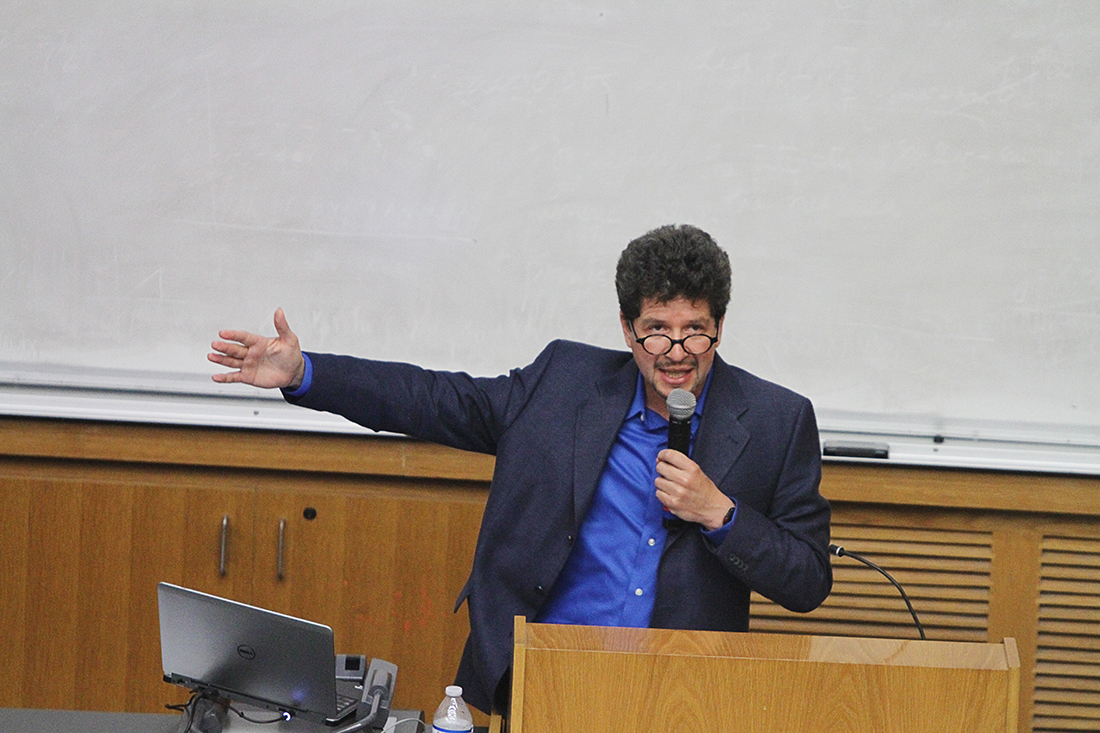
Andrés Reséndez, author and professor of history at the University of California, Davis, speaks to students and faculty about his book, “The Other Slavery: The Uncovered Story of Indian Enslavement in America,” last week as part of the Global Latin American Lecture and Engagement Series on the Edinburg campus. BRYAN RAMBON/THE RIDER
Mexican historian and award-winning author Andrés Reséndez visited UTRGV last week to discuss his most recent book, “The Other Slavery: The Uncovered Story of Indian Enslavement in America.”
The lectures, held April 17 and last Tuesday, were part of the Global Latin American Lecture and Engagement Series, which was founded in early 2016 by UTRGV history assistant Professor Bonnie Lucero.
His highly acclaimed book suggests it was mass slavery by the Europeans, rather than epidemics, that reduced Native American populations across North America.
Reséndez was awarded the Bancroft Prize for “The Other Slavery.” The prize is awarded annually by the trustees of Columbia University and is considered one of the most prestigious honors in the field of American history.
“It was an authentic presentation by one of the top people in the field,” said George Diaz, an assistant history professor. “Andrés Reséndez is one of the top historians in borderlands and Latin American history. … He basically got us to reconsider the way slavery worked in the Americas by including Indians in the story, so rather [than] being strictly a history of African American slaves, it means we’re also [enslaved] and it caused tremendous demographic collapses, and it’s part of the American story that had not been explored really fully until this book.”
Diaz, who suggested inviting Reséndez to talk at the Global Latin American event, said the History Department is trying to present a face that students see as familiar and relevant.
“One of the things we love about him is that he is very relatable and engaging with the students and is accessible,” he said.
Reséndez, who worked on the book for seven years, said there was a close relation between epidemics and slavery.
“Slavery serves to spread germs, which results in more mortality, and when there is more mortality, there are more workers to replace through other raids, so both things form a vicious cycle … which is mutually reinforced,” Reséndez said.
During the lecture, Reséndez, a professor at the University of California, Davis, presented evidence to support his suggestion, such as a map from the Caribbean island group, Hispaniola, at the time of Columbus and a map of 1517. The maps illustrated the decrease of Native Americans from 26,000 to 11,000.
His seminar included the subjects of the Gold Rush, the Pueblo Revolt of 1680, and the Comancheria between Nuevo Mexico and Texas.
“Slavery of Africans reached 12.5 million … and Native Americans, 2.5 to 5 million,” he said. “The number is smaller but we are talking about millions of human beings.”
Reséndez also discussed the 13th Amendment and asked the audience to reflect if the “new slavery” is, in fact, really new. He pointed out that even though slavery has been forbidden since 1542, it has continued across the world.
“In some way this Indian slavery gives us a very important antecedent for the kind of slavery that exists nowadays, in the sense that enslavement of Indians occurred even though it was forbidden, just like slavery today is forbidden across the world,” he said. “And yet … the people that benefit from this type of work resort to all kinds of subterfuges, all kinds of euphemisms and all kinds of institutions, whose name is not slavery but is in all aspects but the name.”
History junior Griselda Cuellar said this was a fascinating subject.
“All throughout high school, junior high, and even my first two years of college, all I would hear would be the American or the very Anglo version of history,” Cuellar said.
Cuellar, who is reading “The Other Slavery,” said the evidence presented in the book was really solid.
“It’s true that disease had a lot to do with the indigenous people near extinction, but then as you read his book, and he presents all these other cases and examples you can’t ignore, the fact that there was slavery and that it did decrease their numbers and it kind of scattered people. So, you have these tribes and then they were reduced to only nomads, or they had to merge with other tribes to kind of survive.”
Asked why it’s important to have trustworthy history, Reséndez said it’s because “sometimes we have a very skewed vision of the history and we don’t understand what has happened.”
“Having a more reliable and tied-to-reality vision always helps us to understand our current reality,” he said.





